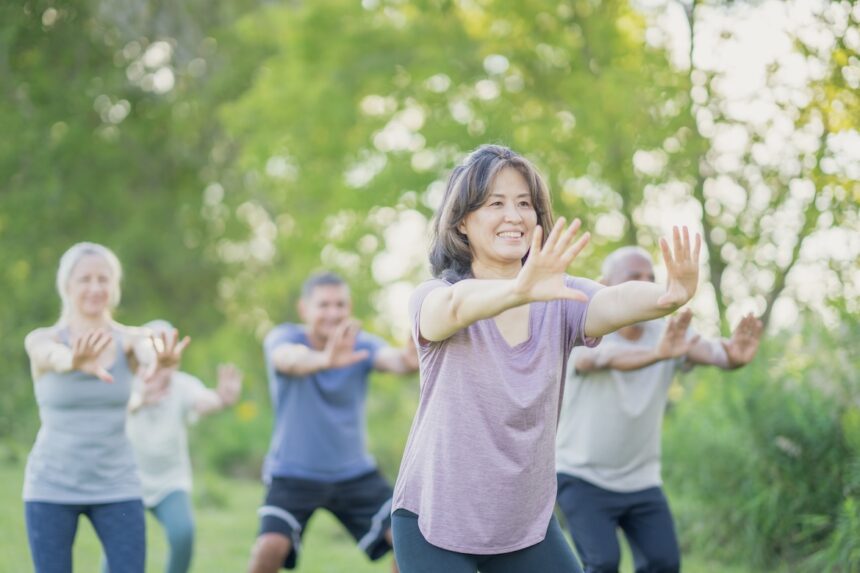About quarter-hour into my on-line tai chi class, a notification popped up on my laptop computer about an e mail I’d been ready for all morning. I dropped the train we had been doing and ran over to examine what it mentioned. As quickly as I did, although, I regretted it: I’d damaged the meditative, stress-relieving spell I’d been in. Even my fingers had been tingling!
Fortunately, as soon as I jumped again into the motion, inside a couple of breaths, I felt my coronary heart fee calm and my shoulders chill out down my again once more. I ignored notifications for the remainder of class to ensure I may absorb all the advantages of tai chi whereas I had the chance.
Though tai chi could also be an historical follow, trendy train science reveals it might probably result in a longer1, more healthy2 life in a lot of methods. (Try extra workouts for longevity!)
“It isn’t only a bodily train,” says Mike Ng, DACM, CES, a tai chi grasp who can be a physician of acupuncture and Chinese language drugs. “It’d begin as that, however it’s actually a full mind-body expertise.”
What’s tai chi?
There are a number of myths and legends surrounding tai chi’s origin story. However historians agree that tai chi began as a martial artwork in historical China.
“It combines martial arts methods with conventional Chinese language philosophy, meditative respiratory methods, [and] theories drawn from conventional Chinese language drugs,” Dr. Ng says.
Tai chi advanced with the philosophies of Daoism and Confucianism, ultimately changing into a mind-body follow, in line with the Smithsonian. At this time, it’s most frequently used as a mild type of train.
In distinction to your typical fitness center exercise, nevertheless, tai chi focuses on enjoyable the muscle tissues quite than tensing them—it’s a restorative follow. With tender, round actions, practitioners transfer slowly and intentionally to advertise the circulation of power (known as “qi”) all through your physique. Dr. Ng says the follow is designed to assist us steadiness opposing energies in an effort to encourage good well being, which is a basic tenet of Chinese language drugs.
“Tai chi permits us to expertise the rules of yin and yang in our personal our bodies, after which begin to apply them to all elements of life,” he says.
The several types of tai chi
As tai chi unfold over the centuries, a number of totally different kinds developed. At this time, most trendy practices stem from considered one of 5 main traditions. Right here’s how Dr. Ng distinguishes each:
- Chen: Essentially the most authentic model of tai chi, Chen most carefully resembles martial arts and contains bursts of energy like stomping, leaping, or kicking.
- Yang: With easy, swish actions practiced at a good tempo, Yang is the most well-liked kind of tai chi practiced around the globe.
- Wu: This originates from Yang model, however is characterised by forward-leaning postures.
- Solar: This model is usually known as “tai chi for arthritis” as a result of it’s straightforward on the joints, with forward-and-back shuffling footwork that doesn’t demand an excessive amount of leg power.
- Wu/Hao: Targeted on inner growth with small, delicate actions, that is the least frequent of those 5 foremost kinds.
“The extra you follow tai chi, the extra relaxed you get, each releasing bodily stress—any form of aches and pains—but additionally psychological stress like stress and anxiousness.” —Mike Ng, DACM, CES
6 advantages of tai chi that’ll persuade you to offer it a strive
1. It’s very enjoyable
As a type of shifting meditation, tai chi’s repetitive motions can carry us into a peaceful, deeply inner state like that “spell” I felt I used to be beneath.
“We dwell in very annoying occasions,” says Margaret Olmsted, who has been educating with the Tai Chi Basis since 1976. “Something that helps you middle and chill out and breathe is sweet. And tai chi is superb in any respect of these.”
The relief is each bodily and psychological, Dr. Ng factors out: “The extra you follow tai chi, the extra relaxed you get, each releasing bodily stress—any form of aches and pains—but additionally psychological stress like stress and anxiousness.”
2. It will enhance your steadiness
We start to lose our means to steadiness after age 503, Olmsted factors out. Tai chi generally is a means to enhance our steadiness so we don’t lose it.
“It is actually good for fall prevention,” Dr. Ng says. Science backs this up: One 2023 examine revealed in Frontiers in Public Well being discovered that tai chi (significantly yang model) can enhance steadiness in older adults. One other 2024 examine within the Journal of Neurology, Neurosurgery & Psychiatry discovered practising tai chi can scale back motor signs in sufferers with Parkinson’s illness, resulting in fewer falls.
3. It could assist scale back ache for sure situations
The sluggish, light actions and targeted respiratory of tai chi may assist ease a few of your aching. Specifically, if in case you have low-back ache6, fibromyalgia, or osteoarthritis in your knees7, science reveals that tai chi can lower a few of the ache.
4. It is good in your lungs
Specializing in integrating your breath with motion by way of tai chi could be good in your lungs as nicely. A 2021 evaluate by The Nationwide Middle for Complementary and Integrative Well being8 discovered tai chi was higher than respiratory workouts alone or strolling at serving to enhance lung operate in folks with persistent obstructive pulmonary illness (COPD).
5. It will provide you with a cognitive increase
Tai chi can provide your mind a wholesome exercise, too. One 2019 examine revealed in Scientific Interventions in Ageing discovered tai chi may enhance short-term cognitive operate on the onset of dementia in older adults.
6. It will show you how to sleep simpler
With its enjoyable, stress-relieving results, it’s not stunning that tai chi has been proven to assist with sleep. Particularly, a 2024 examine revealed in Frontiers in Neurology discovered that tai chi may enhance sleep high quality, prolong sleep length, and scale back daytime drowsiness.
One of the best tai chi strikes to do
Each tai chi practitioner may have their very own favourite actions. Under, Olmsted and Dr. Ng share a few of theirs go-to tai chi workouts for freshmen at dwelling.
1. Thrust back left and chase away proper

- Stand together with your toes hip-width aside, arms down at your sides.
- Take a step ahead together with your left foot and concurrently raise your proper heel off the bottom, twisting your torso barely to the left.
- Convey your left hand as much as chest top. That is chase away left.
- Step your proper foot ahead and concurrently raise your left heel off the bottom, twisting your torso barely to the suitable.
- Convey your proper hand as much as chest top. That is chase away proper.
2. Brush the knee

- Start this transfer in a T-stance the place your proper foot is planted and your left foot is out to the facet, heel on the bottom and toes dealing with towards the sky.
- Elevate one your proper hand up, palm pacing entrance.
- Your left hand is in entrance of the physique, palm dealing with downward.
- Twist your torso barely to the left and push your raised hand ahead, whereas placing the other hand down.
- Bend your proper knee so far as you may and prolong your left leg out to the facet.
- To complete, circle your arms again to beginning place.
- Exhale on the push with the highest hand and inhale on the circle again.
3. Parting the wild horse’s mane

- Maintain an imaginary ball with relaxed arms. Step ahead, however don’t shift your weight ahead.
- Shift your weight to the center.
- Flip ahead and shift your weight ahead. Maintain your again heel down.
- Transfer your arms up and down in reverse instructions.
- Shift your weight backward. Maintain your physique vertical and switch out of your hips.
- Shift your weight ahead. Convey your again leg ahead. Type the ball together with your arms.
“It’s a lifelong journey. So simply benefit from the course of and have enjoyable with it.” —Mike Ng, DACM, CES
Tricks to get began
1. Discover the suitable trainer
As a result of the tai chi expertise is a lot in regards to the power you are feeling, Dr. Ng suggests ensuring to discover a trainer you vibe with. Word: Tai chi instructors don’t should be licensed, although there are certification packages with various standards so it may be useful to look right into a trainer’s expertise and training.
Happily, even in case you don’t dwell in an space the place you may follow tai chi in individual, there are a number of beginner-friendly on-line lessons you may be a part of, together with some at no cost from the Tai Chi Basis, Olmsted factors out.
2. Follow usually
As soon as you start, the easiest way to choose up tai chi is to do it usually, even in case you solely have 5 minutes a day, Dr. Ng says. “If you happen to’re practising one motion or two actions each day, that consistency actually goes a good distance.”
3. Discover that steadiness of power
One of the crucial useful issues to give attention to to start with is discovering a steadiness between leisure and help, being neither too tense nor too free in your physique. “There may be freeness throughout the type, but additionally type throughout the freeness,” Dr. Ng says.
4. Begin with high quality quite than amount
As a beginner, it might probably really feel like there’s quite a bit to be taught. However Dr. Ng suggests protecting your focus slender.
“Do not get too consumed with studying what the subsequent man’s studying,” he says. “It is good to be impressed by a few of the extra superior actions. However you will discover the true profit shouldn’t be if you’re chasing new actions, however if you domesticate and work at what you are at present studying.”
FAQ
1. Who can do tai chi? (And who cannot?)
The quiet, tender actions of tai chi could be executed by almost anybody. This could make the follow a draw for seniors in addition to folks recovering from damage—it’s a low-risk, low-impact solution to preserve shifting. Though it’s historically executed standing, Olmsted says she typically has college students who take class in a seated place, focusing solely on the higher physique.
That doesn’t imply it’s solely for individuals who want a safer exercise. Dr. Ng says he teaches folks of all ages and skills: “I do have college students [who are] retired. However I even have faculty college students, graduate college students, working professionals who’re discovering that it is actually helpful for stress administration, for focus, temper, sleep, all of these items.”
2. Are there any disadvantages to tai chi?
Tai chi could look straightforward, however the focus and endurance required could make it surprisingly tough. “To take it to the upper ranges, to actually be capable to do what a few of these exceptional folks can do takes a number of effort and time and focus and funding,” Olmsted says.
3. How exhausting is it to be taught tai chi?
Though Olmsted admits it’d really feel simpler to choose up the actions if you’re youthful, anybody can do tai chi so long as you’re devoted. “It’s a lifelong journey,” Dr. Ng provides. “So simply benefit from the course of and have enjoyable with it.”










